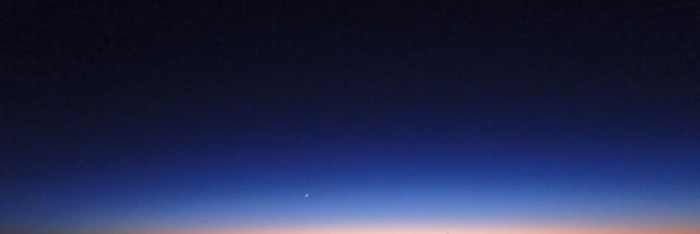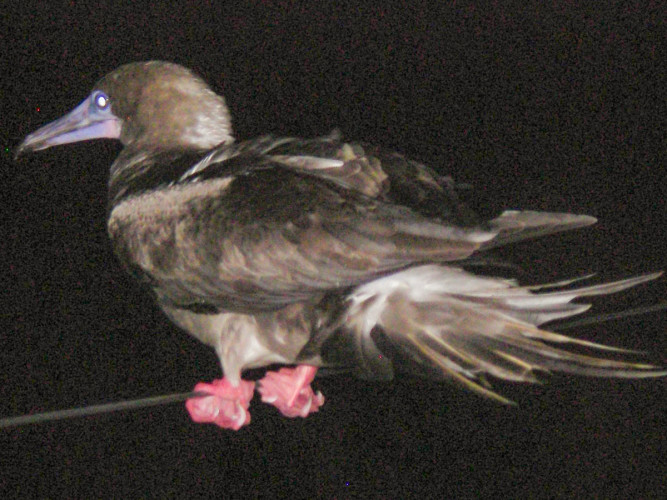The human race seems to have an inherent fear of the dark. This fear is reinforced by books and movies that continually relate darkness with evil. Vampires, zombies, muggers and creepy crawlies all come out after the sun sets. It’s no wonder that sailors tend to have an increased level of anxiety when the topic of sailing at night comes up. We fear the unknown! Darkness inhibits one of our critical senses . . . vision, which leads to unknowns and creates fear in all of us.

As the last piece of daylight passes over the horizon, our anxiety level increases, but there is a beauty to the night sky that helps overcome some of that stress.
Reflecting back on a couple of hundred nights that I have spent at sea, brings memories of some of the most amazing experiences I have had.
West of the Galapagos
Seven nights west of the Galapagos, I saw a brilliant green glow on the imperceptible horizon. It appeared to be small and fairly close, but the lack of depth perception was tricking me. Sailing at 6 knots, I was surprised that it took a few minutes to come up on the strange glow. As the boat approached the field of green, it grew larger and extended 100 meters in all directions. Slowing the boat, I cautiously entered this twilight zone, as the hair on the back of my neck stood upright. Was I to be swallowed into the abyss and become a statistic of unexplained losses at sea?
My anxiety quickly turned to delight as I realize there are thousands, no, millions and millions of sea creatures “playing” near the ocean’s surface, emitting the green glow. This was either part of a mating ritual or they had been corralled by larger creatures looking for a huge feast. Only half way through my watch, I had to share the experience with Carol, sleeping below. However, just as quickly as I came upon the phenomena, the green glow fell behind in our wake.

Having a mate to keep watch with you will help you stay alert, and an extra set of eyes on the horizon is always an asset.
As it turns out, our vessel emits its own attractive green glow. Our starboard navigation light is very close to the color emitted by the sea creatures, and for the next few nights, we had dozens of small squid that jettisoned themselves up to the navigation light. Their aim was terrible, some trajectories taking them a dozen or so feet in the air, as they made desperate attempts to play with our navigation light. Upon the arrival of daylight, we would spend a half hour or so removing dozens of carcasses from the deck.
Crossing the Atlantic
There was one night while crossing the Atlantic Ocean, that the sky became brilliant as daylight for a few seconds as a large meteor streaked across the sky and ignited as it entered earth’s atmosphere. Then, there are all the other nights, no two being the same. A moonless night with billions of stars randomly scattered across it. Those slivers of silver moons, that over a dozen days build to fiery red balls rising from the horizon. This fiery ball becomes a brilliant white as it levitates overhead, casting your shadow across the cockpit as you read a book by its light. There are also eerie nights of nothing . . . complete darkness, as if your eyes are shut tight. The boat could be meandering in circles, completely unnoticed except for the binnacle compass spinning like an erratic top.
Night sailing is an awe-inspiring experience, but that evil side of darkness does have serpents that love to wreak havoc on your vessel. My documented calculations prove that the odds are pretty good, if something is going to go wrong, it usually happens at night. Squalls, torn sails, chafed lines and broken rudders generally happen in the cloak of darkness.
Sailing at night is a favorite time for me, but I am always relieved as we welcome that brilliant sunrise on the horizon every morning.
Tips for Night Passages
Here are a few notes and tips to help make your night passage serpent free:
- Build confidence by completing your first night passages in familiar waters. Plan to be in areas where hazards are known to you and well-marked. Go out on a clear night with an almost full moon to improve visibility.
- Plan your passages so that you are leaving land and making landfall in daylight. I have a long standing rule to never make landfall in the dark. I did break that rule once, and came close to losing my boat to the serpents. Never again!
- Complete an on-deck inspection of all rigging, sails and related gear thirty minutes before sunset, every night. Carry out remedial action prior to darkness setting in. Tidy up all lines and clean cockpit. It is amazing how many times you will come across a small issue (loose shackle pin or chaffing line) that may cause complete chaos during the upcoming night.
- If shorthanded, consider reducing sail prior to nightfall.
- Ensure that you are “clipped on” to the vessel at all times. The tether/pad eye/jack line system must be designed to keep you on the deck if you stumble. Being dragged through the water at 5 knots will be the second scariest event of your life. The first will be when you cut yourself free in a desperate attempt to prevent drowning and watching your vessel sail off into the darkness.
- Depth perception is inhibited at night. It is difficult to determine whether a vessel or buoy is a hundred meters away or thousands.
- All cabin lights, flashlights and headlamps should have a red setting. Night vision can be severely impaired by ambient lights. It can take tens of minutes to recover your night vision after being subjected to bright white lights. Red light has less impact on your night vision.
- Know what different light colors and flashing sequences mean, enabling you to identify aids to navigation and other vessels.
- Use proper navigation lights so other vessels can identify you. DO NOT use a strobe light as a means of making yourself visible. Strobe lights on the water are used to signify DISTRESS and EMERGENCY (Life raft, COB, etc)
- AIS is a great tool for collision avoidance, however not all vessels are transmitting or receiving a signal. If you want to make yourself visible, use a transceiver.
- Radar will help you see well into the darkness, however small targets can easily be missed. Make sure you scroll up and down through the range selections on a regular basis.
- Update your position on a paper chart more frequently if in coastal waters. If you lose your electronics… you will be lost, with few if any visual references to find your way.
- Set up a formal watch schedule that works for the number of crew you have on the boat. Stick to the schedule. All crew members need equal rest.
- Crew member on watch must understand their duty to be vigilant about KEEPING WATCH, even more so at night. Stray logs or fishing buoys are hard enough to spot during the day, they are virtually invisible at night.
- Keep active during your watch and set up a routine to keep you alert.
- Hand steer for part of the watch. This will let you know how the boat is reacting to the wind and sea conditions. Is it balanced? Do sails need to be trimmed? The visual clues are not available at night, so listen for sound clues – flogging sails, clanging lines…
- Complete a 360 degree visual scan of the horizon every few minutes.
- Plot position and course on the paper chart every couple of hours or watch change.
- Log relevant information in logbook and note weather conditions.
- Run radar as frequently as conditions require.
- Prepare and eat snacks.
- Develop a routine of exercises that can be done safely in cockpit.
- Prepare a warm drink for new crew coming on watch.






Your article brings back lots of memories, Ken! I love the night watches, despite all the “serpents” that are definitely out there and that we have encountered! We have a similar night time checklist on Camdeboo and following those tips or “rules” makes a huge difference to the comfort level of skipper and crew.
An excellent article Ken. I especially like the final bullet.
Really enjoyed your thoughts on night sailing. It is usually a magical time that cannot be found in any other environment.
A great article Ken. Thank you for it. It brought back many memories of night watches aboard Alcyone. When the moon wasn’t bright enough to read by, I’d attach one ear-piece of my purpose-bought head set to one ear, keeping the other one free to ear what was going on around me, and listen to the BBC on the SSB. It helped me feel somewhat connected to the world and there was less to catch up on after a long ocean crossing.
The other aspect of a ‘routine’ that I found comforting was the sense of comfort one gets from the familiarity aspect and the security in the knowledge that one can rely on one’s fellow shipmate(s). Uncertainty and mistrust of that shipmate and what will happen next would, I’m sure, create trepidations akin to those experienced when one doesn’t trust one’s vessel or the competence of the crew. Comfort levels or the lack thereof can be effected by many things; it is important to identify threats to that comfort and make every attempt to raise them to the highest possible level, to ensure not only complete enjoyment of the trip, but the success thereof. Again, thank you.
Good information! I agree that strobe lights are intended for Emergency or Distress use, and should not be used non-selectively. However, I would point out that masthead strobes can serve a useful purpose when activated to make one more visible. While sailing between Tabuaeran and Hawai’i, we encountered a cruise ship at night who responded immediately to our radio hail but was unable to pick us out in the rain. Turning on our strobe for a few seconds allowed the bridge officer to spot us quickly.
Night watches are often lots of fun! Thanks!